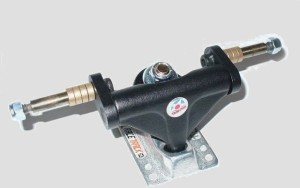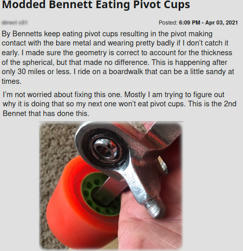
“Under capitalism, all questions of what we need, what we want, and what is durable, must be subordinated to the question of what is profitable.”
Hägglund, Martin. This Life: Secular Faith and Spiritual Freedom. 1st ed. New York, N.Y., U.S.A.: Pantheon Books, 2019.
I don’t know where the problem starts. Is it the consumers who would buy, literally and figuratively, anything? Or is it rather the skate companies who would sell to the consumers anything, if they asked for it? It certainly is a vicious circle.
Introduction
In the first half of this text I enumerate a few cases whose similarity shows, I think, that they are all outcomes of the same mechanism: a regressive feedback loop between skateboard brands and consumers; a vicious circle. In the second half, I ask and try to decide who, brands or consumers, is better placed to break the loop. The conditions that brought about and/or preserve this mechanism are beyond the scope of this article.
Examples
First things first: what is so vicious about this circle?
Tracker Offset

Take this inanity as an example. Tracker used to market this, following a past demand for “offset” trucks. Independent also had a model. (It should be clear to the reader that the axle’s position relative to the kingpin has no consequence on the truck’s behavior. I discuss this in more detail here) This is a very expensive (and wasteful) piece of engineering, remarkable in its own right, but even more remarkable for its entirely fictional benefits.
I don’t know why this thing was made. Did Tracker (and Independent) take the initiative because they thought it’d be actually useful? Or did the skater community in its forums discuss how a product like this would be helpful? My guess is that the latter happened and then Tracker rushed to satisfy this demand. Did Tracker know it’s stupid at that point? I don’t think so, but (crucially) from Tracker’s point of view it really doesn’t matter, because the demand was there waiting to be satisfied. As any company under capitalism would, they simply jumped in ASAP to satisfy the demand, before other competitors did.
0° trucks

Or look at all those 0° trucks. I was already active in the community when they started marketing those. I remember shortly before that, there were a few forum threads where hobbyists would mount RKP trucks reversed and wedged at around 0° at the back, usually on a Subsonic Century (Subsonic had started drilling their decks to accommodate for this eccentricity). People thought it was cool, and started seeing it as an end in itself, no questions asked. Suddenly the 0° thing became mythologized; a thing that supposedly helps with pumping, without any further explanation. People just thought it’s good; magic, even, but not in these words. Sure enough, soon after Don’t Trip came through for them. G|Bomb also offered a solution, which, to their credit, did have advantages over traditional trucks (i.e., low weight and the elimination of urethane as a return-to-center force), though reportedly it’s also a bit fragile. Other companies jumped in too. 0° trucks are here to stay and to capture the collective imagination with… nothingness.
Sabre’s graph

And when the companies produce these kinds of bullshit products, they legitimize and validate the perceived benefits of said bullshit. And the bullshit perpetuates. When I pressed Sabre to respond why they have published a bullshit graph to “explain” what rake does for the turning per lean relation of a truck (which helps justify selling hangers with minimal rake differences), they replied that the graph is not meant to be accurate, but merely to represent what their customers feel rake does! The circular logic of this is staggering. (I guess, if we need to see the value in the graph, we should take the graph as a sociological survey conducted on behalf of Sabre). Of course, other visitors of the webpage were not so audaciously inquisitive as I. They were grateful to the company for “clarifying” to them what rake does. As I have bitterly found, it is next to impossible to dislodge this false idea (the one depicted in the graph) from the brains of the community. (In fairness, their RKPs are an interesting proposal. The fact that they fell in this conceptual pitfall -and Sabre is not alone- shouldn’t reflect badly on their products; after all, they follow the old trusty template.)
Bennett Vector
And what to make of the most celebrated piece of junk passing for sports equipment I’ve seen in my life, namely Bennett Vector, a product far worse than what the cult-like devotion it enjoys in the community would have one expect? A truck that requires the consumer to spend many hours (not to mention resources in materials and tools) mitigating faults its manufacturer ought to at least have partially addressed in the last five decades it’s been proudly produced unchanged, while Bennett refuses to, because it declares it a work of a “genius, a mad scientist.” The public gets what the public wants.
Independent

Bragging that you haven’t improved your design one bit for five decades would sound perverse in other industries, but actually Bennett is, under these particular circumstances, somewhat justified. An illuminating exposé on Independent, published by Jenkem, shows how the company was pressured by its “followers” (sic; the word “customers” is inadequate for the brand adoration found in skateboarding and that’s reflected by the author’s word choice) to actually regress. The newer iterations (or, as the company calls them, “stages”) of its flagship truck line are copies of the 80s models. “No sane company would compete with its own back catalog” (Luecke, 2018); unless we’re in skateboarding, that is. Granted, in the period prior to that, the company had apparently been fumbling in the dark for improvements which proved to be elusive. Independent simply failed to stumble upon any. Its decision to return to older, probably better and definitely more successful designs is understandable. Thus, the circle back to where we started is completed.
Dilemma
So: how do we get escape from this circle? Is it mostly the skate community or the skate industry to blame and who must change their ways? These questions are the hardest for me to answer. They’re in essence normative: do you believe that the citizen in a democracy bears the responsibility for a well-functioning economy, or do you blame capitalist institutions for perpetuating the vicious circle? Civil society or market?
On the one hand, aren’t the companies simply doing what companies under capitalism must do to survive? They’re only looking for the most efficient way to make a profit, even if it is more “efficient” to entirely bypass R&D and simply survey public forums for products consumers would buy. However, this in effect represents a version of the is-ought fallacy: just because companies are in essence market institutions whose purpose is to make profit, it doesn’t mean they’re not accountable for deception or exploitation.
On the other hand, shouldn’t we absolve the public of the responsibility to control the market for deception? After all, the public in this case is consumers with limited free time and an excess of trust on manufacturers presumed to do R&D. Furthermore, consumers are probably accustomed to following trends as a shortcut around time-consuming surveys of quality of the products. Isn’t then the public off the hook? No, I disagree with this line of thinking, not least because it would make us complacent. Also, that would be another version of the is-ought fallacy: just because consumers are humans wired to follow trends, it doesn’t mean they don’t have the responsibility to examine their own role in fostering these trends.
I think we have to see the reality on the ground to make this call. The skateboard industry is very small. In all the examples I mentioned above the companies are probably just as ignorant about the factual mistakes they’re making as the consumers are (I’m sure Sabre would be just as surprised as anyone to find out about their mistake, Bennett never considered even trying to fix their pivots because we keep telling them the Vector is just fine as it is, Dan from Dont Trip just follows forums and then makes products, etc; all of them are just small businesses without formal training who are too lazy to try to understand their own stuff as long as the profit keeps coming). So, back to the question: civil society or market? I’m inclined to place more weight of responsibility on the former, but there’s no real reason to choose either one. It is a shared responsibility of all of us.
I want to thank kook55, whose counterpoint on the public’s culpability helped me sharpen my argument.
